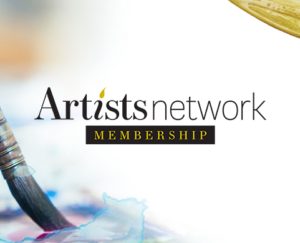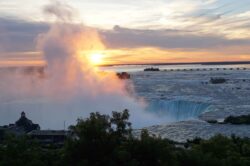Beginner Drawing Logic: Perspective Basics

 A knowledge of the three major perspective systems will allow you to create a convincing space in your drawing. Check out this primer on the subject.
A knowledge of the three major perspective systems will allow you to create a convincing space in your drawing. Check out this primer on the subject.
In scary films, a character somehow senses that something unidentifiable is very wrong as soon as he or she steps into a room. A surefire way to get a similarly unpleasant effect in a drawing is to be careless in handling perspective. The viewer will know something is wrong, even if it is not readily apparent. To make a convincing space, keep in mind the following three types of perspective systems, and implement the one most appropriate for your drawing.
Perspective is the visual effect that makes a square wall into a parallelogram and makes train tracks meet in the far distance—in your mind’s eye. The simplest way to ensure proper perspective is to adhere to a one-point perspective. This is easy: draw the horizon line in your composition, and then consider the line of sight—the exact direction that the viewer’s eye is meant to go. The intersection of these two lines is the vanishing point.
Once the vanishing point is established, the artist must simply ensure that all lines that recede into the distance on a parallel to the viewer’s line of sight—be it a row of trees, the roofline of a building, the molding along a ceiling, or rows of grapevines—intersect at the vanishing point. These lines are called convergence lines. (See Fig. 1 pictured right)
Two-point perspective is useful when a cube or rectangle is being viewed from an oblique angle—that is, if the viewer is looking at or into a corner. To correctly render the convergence lines in this situation, first establish the horizon line, then find the vanishing points at either side of the box’s corner. (See Fig. 2 pictured top half of below image) The box’s lines along the ground or floor, together with the lines along the roof or  ceiling, will determine these vanishing points—assuming that the floor and the roof are parallel planes.
ceiling, will determine these vanishing points—assuming that the floor and the roof are parallel planes.
The third type is three-point perspective. This system allows you to draw from a worm’s-eye view or a bird’s-eye view. Three-point perspective is two-point perspective with the addition of a vanishing point either in the sky or in the ground. If you are looking up at a building at an oblique angle, the left and right outside edges of the building, normally parallel in one- and two-point perspective, converge toward a meeting point in the sky—assuming the building is shaped like a box or otherwise not designed by Frank Gehry.
A tall building scene from above will have convergence lines that meet underground. Obviously, the horizon line does not play a role in finding this third perspective point. (See Fig. 3 pictured bottom half of image left)
Similar geometry can help an artist accurately draw shadows—by drawing lines from the light source to the edges of the object casting the shadow, then continuing these lines onto the shadowed surface.
 Artists Network Membership - 1 Year
Artists Network Membership - 1 Year  Breakthrough Paint Along: Where Mixed Media Combine Together
Breakthrough Paint Along: Where Mixed Media Combine Together  Paint Along 127: Paint the Motion of the Sea
Paint Along 127: Paint the Motion of the Sea  Breakthrough Paint Along: The Big Value of Miniature Landscapes
Breakthrough Paint Along: The Big Value of Miniature Landscapes  Portrait Painting: Rembrandt's Techniques Video Download
Portrait Painting: Rembrandt's Techniques Video Download  Figure Drawing Tips with Brent Eviston Video Download
Figure Drawing Tips with Brent Eviston Video Download  Southwest Art August/September 2025 Digital Edition
Southwest Art August/September 2025 Digital Edition  Artists Magazine July/August 2025 Digital Edition
Artists Magazine July/August 2025 Digital Edition  Pastel Journal Summer 2025 Digital Edition
Pastel Journal Summer 2025 Digital Edition  Artists Magazine March/April 2025 Digital Edition
Artists Magazine March/April 2025 Digital Edition  Artists Magazine January/February 2025 Digital Edition
Artists Magazine January/February 2025 Digital Edition  Best of Watercolor: Winners of the Splash 26 Competition Print Edition
Best of Watercolor: Winners of the Splash 26 Competition Print Edition  Southwest Art June/July 2025 Print Edition
Southwest Art June/July 2025 Print Edition  Artists Magazine May/June 2025 Print Edition
Artists Magazine May/June 2025 Print Edition  Southwest Art 2021 Digital Collection × 1
Southwest Art 2021 Digital Collection × 1  Watercolor Artist 2020 Digital Collection × 1
Watercolor Artist 2020 Digital Collection × 1  Watercolor Artist 2019 Annual Digital Collection × 1
Watercolor Artist 2019 Annual Digital Collection × 1  Watercolor Mega Magazine Collection × 1
Watercolor Mega Magazine Collection × 1  Pastel for Beginners Workshop
Pastel for Beginners Workshop  Composition & Design for Landscape Painting Video Workbook
Composition & Design for Landscape Painting Video Workbook  Drawing Mastery: Shading Course
Drawing Mastery: Shading Course  Alla Prima Bootcamp: 4 Weeks to Confident Painting Course
Alla Prima Bootcamp: 4 Weeks to Confident Painting Course  Eight Greats: The Pastel Journal's 10th Anniversary Artist Interview Series Digital Download
Eight Greats: The Pastel Journal's 10th Anniversary Artist Interview Series Digital Download  Secrets of Hyperrealist Watercolor Course
Secrets of Hyperrealist Watercolor Course  Acrylic Artist Summer 2017 Digital Edition
Acrylic Artist Summer 2017 Digital Edition  Exploring Acrylic: Abstract Art in Action Video Download
Exploring Acrylic: Abstract Art in Action Video Download  WetCanvas Live! Paint Stunning Landscapes from Photos: Lesson 23 & 24 Video Download
WetCanvas Live! Paint Stunning Landscapes from Photos: Lesson 23 & 24 Video Download  WetCanvas Live! Paint Stunning Landscapes from Photos: Lesson 9 & 10 Video Download
WetCanvas Live! Paint Stunning Landscapes from Photos: Lesson 9 & 10 Video Download  The Whimsical Face with Jane Davenport Video Download
The Whimsical Face with Jane Davenport Video Download  Mixed-Media Faces Made Easy Video Download
Mixed-Media Faces Made Easy Video Download  What It Takes to Teach Video Download
What It Takes to Teach Video Download  On the hunt for found objects: How to Create New and Eclectic Molds Video Download
On the hunt for found objects: How to Create New and Eclectic Molds Video Download  Urban Sketching: Drawing People in Places Video Workbook
Urban Sketching: Drawing People in Places Video Workbook  Graffiti Grunge Art by Jodi Ohl Video Workbook
Graffiti Grunge Art by Jodi Ohl Video Workbook  Portraits: From Good to Great Video Download
Portraits: From Good to Great Video Download  Low-Tech Metal Apps: Wire, Foil, Mesh, & Screen Video Download
Low-Tech Metal Apps: Wire, Foil, Mesh, & Screen Video Download  Paint Along 126: Simplify Your Landscapes with a Limited Palette
Paint Along 126: Simplify Your Landscapes with a Limited Palette  Experimental Pastel Techniques with Dawn Emerson Video Download
Experimental Pastel Techniques with Dawn Emerson Video Download  Painting Patterned Trees Video Download
Painting Patterned Trees Video Download  Paint Along 125: Paint the Charming Towns of Italy
Paint Along 125: Paint the Charming Towns of Italy  Essentials of Painting Still Lifes
Essentials of Painting Still Lifes  7 Days to a Steady Journal Practice Video Download
7 Days to a Steady Journal Practice Video Download 


Have a technical question?
Contact UsJoin the Conversation!